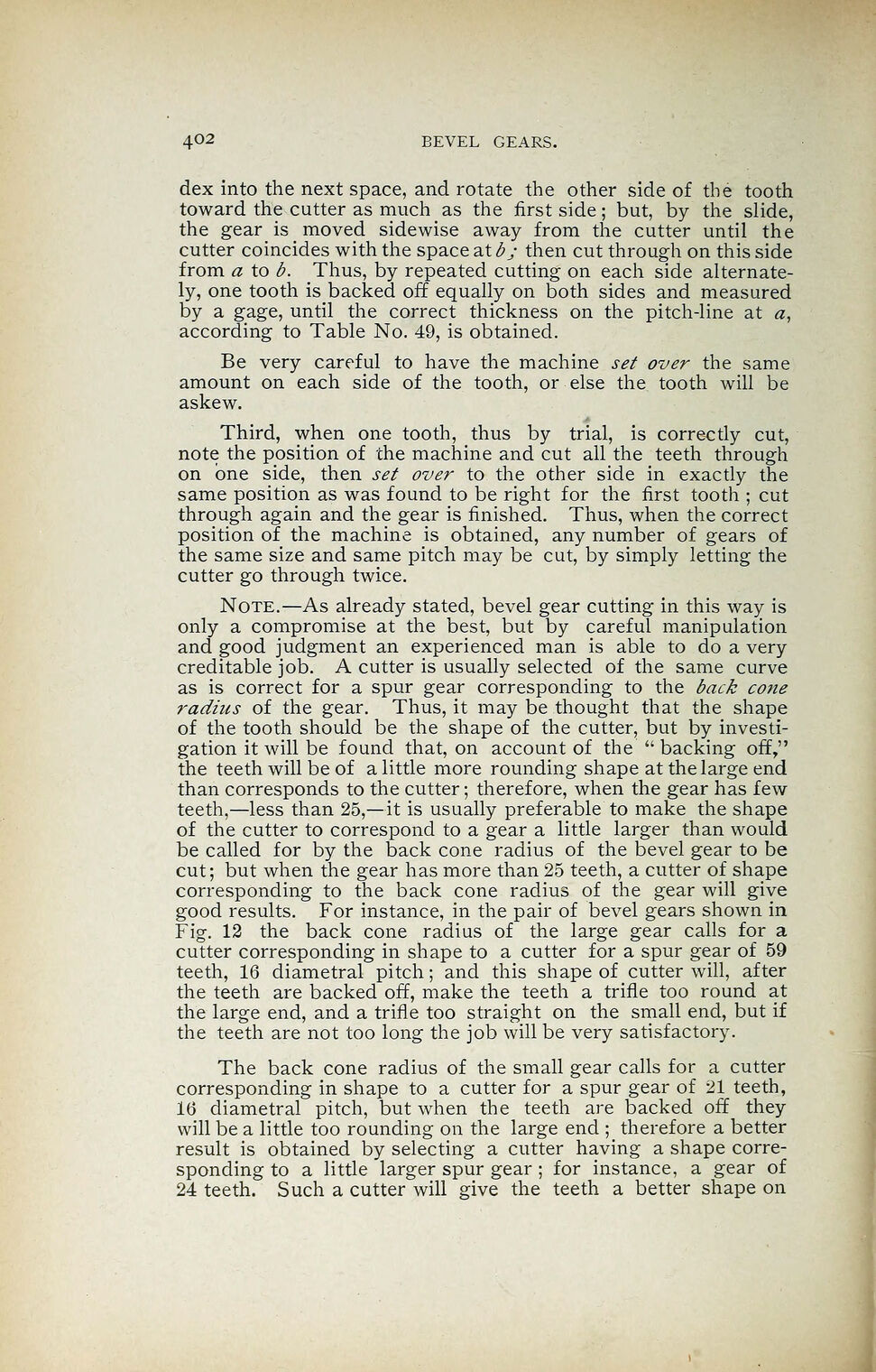
Full resolution (JPEG) - On this page / på denna sida - Gear Teeth - Cutting bevel gears

<< prev. page << föreg. sida << >> nästa sida >> next page >>
Below is the raw OCR text
from the above scanned image.
Do you see an error? Proofread the page now!
Här nedan syns maskintolkade texten från faksimilbilden ovan.
Ser du något fel? Korrekturläs sidan nu!
This page has never been proofread. / Denna sida har aldrig korrekturlästs.
402 BEVEL GEARS.
dex into the next space, and rotate the other side of the tooth
toward the cutter as much as the first side ; but, by the slide,
the gear is moved sidewise away from the cutter until the
cutter coincides with the space at bj then cut through on this side
from a to b. Thus, by repeated cutting on each side alternate-
ly, one tooth is backed off equally on both sides and measured
by a gage, until the correct thickness on the pitch-line at a,
according to Table No. 49, is obtained.
Be very careful to have the machine set over the same
amount on each side of the tooth, or else the tooth will be
askew.
Third, when one tooth, thus by trial, is correctly cut,
note the position of the machine and cut all the teeth through
on one side, then set over to the other side in exactly the
same position as was found to be right for the first tooth ; cut
through again and the gear is finished. Thus, when the correct
position of the machine is obtained, any number of gears of
the same size and same pitch may be cut, by simply letting the
cutter go through twice.
Note. —As already stated, bevel gear cutting in this way is
only a compromise at the best, but by careful manipulation
and good judgment an experienced man is able to do a very
creditable job. A cutter is usually selected of the same curve
as is correct for a spur gear corresponding to the back cone
radius of the gear. Thus, it may be thought that the shape
of the tooth should be the shape of the cutter, but by investi-
gation it will be found that, on account of the " backing off,"
the teeth will be of a little more rounding shape at the large end
than corresponds to the cutter ; therefore, when the gear has few
teeth,—less than 25,—it is usually preferable to make the shape
of the cutter to correspond to a gear a little larger than would
be called for by the back cone radius of the bevel gear to be
cut; but when the gear has more than 25 teeth, a cutter of shape
corresponding to the back cone radius of the gear will give
good results. For instance, in the pair of bevel gears shown in
Fig. 12 the back cone radius of the large gear calls for a
cutter corresponding in shape to a cutter for a spur gear of 59
teeth, 16 diametral pitch ; and this shape of cutter will, after
the teeth are backed off, make the teeth a trifle too round at
the large end, and a trifle too straight on the small end, but if
the teeth are not too long the job will be very satisfactory.
The back cone radius of the small gear calls for a cutter
corresponding in shape to a cutter for a spur gear of 21 teeth,
16 diametral pitch, but when the teeth are backed off they
will be a little too rounding on the large end ;
therefore a better
result is obtained by selecting a cutter having a shape corre-
sponding to a little larger spur gear ; for instance, a gear of
24 teeth. Such a cutter will give the teeth a better shape on
<< prev. page << föreg. sida << >> nästa sida >> next page >>